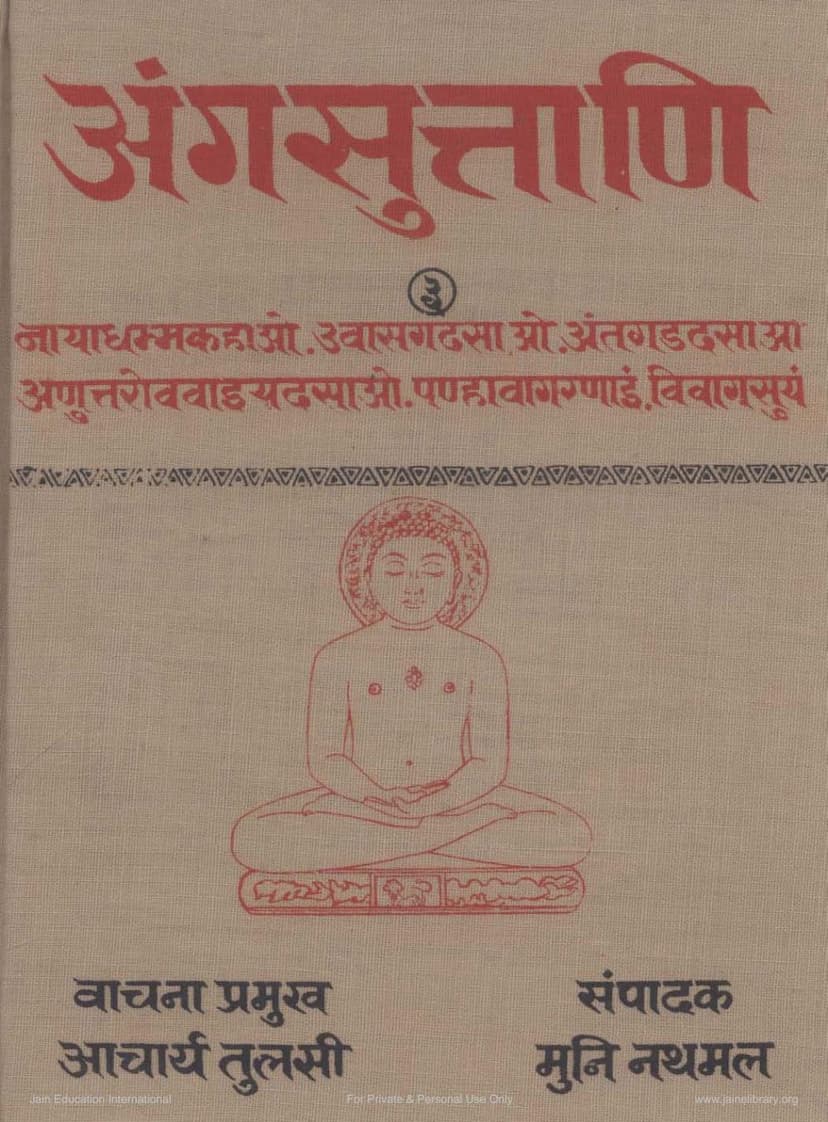Agam 09 Ang 09 Anuttaropapatik Sutra Anuttaraovavai Terapanth
Added to library: September 1, 2025

Summary
This Jain text, "Agam 09 Ang 09 Anuttaropapatik Sutra Anuttaraovavai Terapanth," published by Jain Vishva Bharati and authored by Acharya Tulsi and Nathmal Muni, is a critical edition and commentary of the ninth Anga of the Jain Agamas. It is part of a larger project to critically edit and publish all the Agamas.
Here's a summary of the key aspects of the text based on the provided pages:
1. Purpose and Context:
- The publication is dedicated to the 25th Nirvana anniversary of Lord Mahavira, aiming to present his teachings to the public.
- It is part of a comprehensive effort by Jain Vishva Bharati to publish the Jain Agamas, with this specific volume focusing on the Anuttaropapātikadaśā (also transliterated as Anuttarowawaiyadāsāo), the ninth Anga.
- The project emphasizes a rigorous, scholarly approach to editing and presenting the ancient Jain scriptures.
2. Authorship and Editorship:
- Vachana Pramukh (Chief Preceptor/Guide): Acharya Tulsi, a prominent Jain spiritual leader, provided the guidance and overarching vision for the work.
- Sampadak (Editor): Muni Nathmal (later Acharya Mahapragya) was the principal editor, responsible for the critical collation and textual work.
- Managing Editor: Shreechand Rampuria, Director of the Agama and Literature Publication Department, oversaw the publication process.
- Contributing Monks: Muni Dulharaj, Muni Sudarshan, Muni Madhukar, and Muni Hiralal are acknowledged for their significant contributions to text research and editing.
3. The Anuttaropapātikadaśā:
- Title: The name "Anuttaropapātikadaśā" (Anuttarowawaiyadāsāo) refers to the states or conditions of beings reborn in the "Anuttara" heavens. These are celestial realms considered the highest in the Jain cosmology, where beings achieve liberation (moksha) without further rebirths in lower realms.
- Structure: The text is divided into three Vargas (sections). The first Varga contains ten Adhyayanas (chapters), the second Varga has thirteen Adhyayanas, and the third Varga has ten Adhyayanas.
- Content: The text describes the lives and spiritual journeys of individuals, primarily monks and princes, who attained rebirth in these highest heavens. It highlights their renunciation, ascetic practices, and eventual liberation.
- Specific Chapters (Vargas and Adhyayanas): The text details the contents of each Varga. For instance, the first Varga focuses on individuals like Jali, Dhanya, and Sunakshatra, narrating their lives, renunciations, austerities, and rebirths in Anuttara heavens. The second Varga covers ten individuals starting with Dohsena and Mahasena, and the third Varga lists ten individuals, including Dhanya, Sunakshatra, and Isidasadi. The dedication to rigorous text analysis is evident in the detailed presentation of the manuscripts used.
4. Editorial and Scholarly Approach:
- Critical Editing: The editors did not rely on a single manuscript but compared various ancient manuscripts, considering the context, antecedent texts, other Agamas, and commentaries to determine the most accurate readings.
- Textual Variations: The text acknowledges and addresses textual discrepancies found in different manuscripts, often providing the critical reading based on their research.
- Historical Context: The publication provides historical details about the origin and development of Jain Agamas, including discussions about different Vacanas (recensions or versions) and the lineages of scholars.
- Detailed Indices: The work includes comprehensive indices and a "Correction Sheet" (Shuddhi-Patra) to aid researchers and readers.
5. Publisher and Support:
- Publisher: Jain Vishva Bharati, Ladnun (Rajasthan).
- Financial Support: The project received significant financial assistance from individuals and organizations like the Saravagi Charitable Fund (Calcutta) and Sri Ramlal Hansraj Golchha (Biratnagar, Nepal).
In essence, this volume is a meticulous presentation of a crucial Jain Agama, reflecting a deep commitment to preserving and disseminating the foundational texts of Jainism with scholarly accuracy. It serves as both a spiritual text and a valuable resource for academic study of Jain philosophy and history.